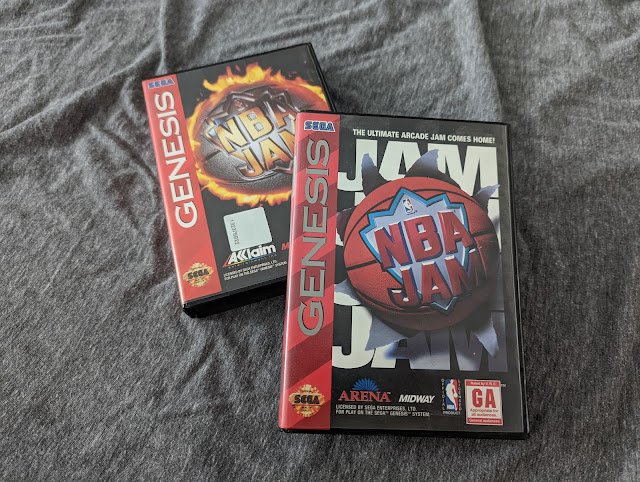 |
| NBA Jam and NBA Jam: Tournament Edition for the Sega Genesis |
Video games and sports are just one of those perfect combinations, like peanut butter and jelly or chocolate and peanut butter. They just go together.
Video games let us do things we're incapable of, like flying spaceships, blasting aliens, and dunking all the way from half court. NBA Jam excelled at the latter, of course.
The arcade hit came to the Sega Genesis in March 1994. It plays a minor role in Sega CD Summer, mentioned as one of the few sports games Tommy's friends would enthusiastically play with him. Tommy also comments on his love for the Indiana Pacers, a team featuring NBA all-timer Reggie Miller and the solid-in-real-life-but-kind-of-useless-in-the-game Derrick McKey.
From the book:
As much as my friends and I liked giving each other crap, we were always supportive. Andy and Kyle didn’t have much interest in sports, but they didn’t mind it when I talked about the baseball team or wanted to play NHL ’94 or Madden. They drew the line at most baseball video games, and the only basketball game they could stand was NBA Jam.Heck, Kyle even owned a copy of NBA Jam. The two-on-two, officially licensed basketball game was pure arcade craziness, with over-the-top dunks and players. I always played as the Indiana Pacers so I could rain three-pointers with the legendary Reggie Miller, while Derrick McKey brought surprisingly little to the table. While he could dunk okay, he was slow and couldn’t shoot. Also, his defensive rating was poor. The Tournament Edition added Rik Smits, who was also slow and couldn’t shoot. His Dunkin’ Dutchman power was completely misrepresented in the rankings, but he could block shots. I always stuck with Reggie Miller and Rik Smits—at least TE gave me the option of benching McKey.
NBA Jam was a certifiable phenomenon in the mid-90s, right up there with Street Fighter II and Mortal Kombat in terms of gaming hype and hours logged. Because of the over-the-top gameplay and presentation ("BOOMSHAKALAKA!"; "He's on fire!"; "Rejected!"; "Is it the shoes?"), the game got that all-important crossover appeal that expanded the gaming audience beyond sports fans.
The game is simple, really, just two-on-two basketball featuring officially licensed NBA teams and players. Most basketball rules get tossed out the window, and the team with the most points at the end wins, obviously. An exuberant announcer and crowd reactions give each game great atmosphere. It's probably best known for jaw-dropping, turbo-enhanced dunks that have players going high into the air, windmilling or sometimes spinning as they throw one down.
The game had some wicked rubber-banding AI that always kept things close in CPU games, dropping your field goal percentage and upping the computer's success rate to keep things "interesting."
I almost always played as the Pacers, but there were some other fun duos, including Sean Elliott and David Robinson on the Spurs; Larry Johnson and Alonzo Mourning on the Hornets; Karl Malone and John Stockton on the Jazz; and Vernon Maxwell and Hakeem Olajuwon on the Rockets. I'll even begrudgingly throw in John Starks and Patrick Ewing on the Knicks, just because it gave me much satisfaction to beat them with Reggie Miller.
It's worth mentioning that, thanks to the complexities of licensing, the home ports lacked Shaquille O'Neal and Michael Jordan. While some early Genesis/SNES versions had Charles Barkley, he was later replaced with Dan Majerle thanks to a deal with Accolade for Barkley: Shut Up and Jam, a venture I'm sure was worthwhile for everyone (eyeroll).
NBA Jam also had several cheat codes and secret characters. You could play in Big Head Mode, for example, or throw one down as Al Gore or Bill Clinton, respectively the vice president and president at the time.
A year after the original Jam hit home consoles, NBA Jam: Tournament Edition arrived. It featured the same fast gameplay, secrets, and atmosphere. The game had expanded rosters and you could do substitutions between quarters. I liked the optional addition of "hotspots," different areas of the court that would light up and reward you with higher point values if you hit a shot.
The Sega CD and Game Gear also received ports of NBA Jam. The Sega CD version, as you'd expect, featured CD-quality music, a few roster updates, and FMV sequences at halftime. Players had to contend with long load times, however, and the graphics weren't much of an upgrade from the Genesis version.
The Game Gear port tried hard, as Game Gear ports often did, and although it's graphically and aurally inferior, it's possible to have some fun with it.
